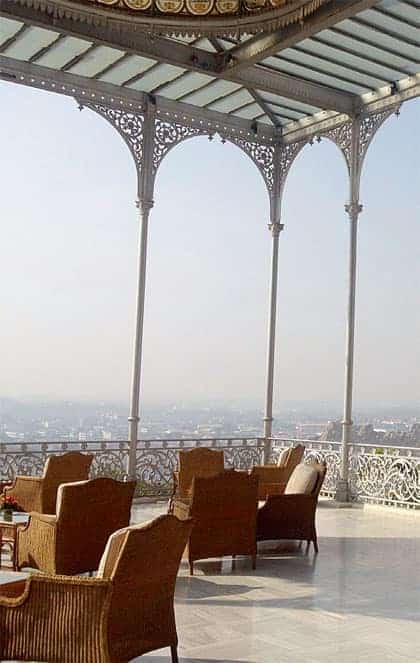Ihave never been welcomed by rose petals before. Rose water, yes; at Indian weddings. But to have rose petals showered on you from above is a delightful way to welcome guests. It is what happens as we climb the marble staircase of the Taj Falaknuma Palace in Hyderabad. My daughters laugh with delight, already in a good mood. No more bickering for the day hopefully. My husband and I glance at each other, bemused by the flamboyance of the welcome.
To enter the Taj Falaknuma Palace involves many steps. You drive to the entrance of the 32-acre palace; then, get on a horse carriage, which takes you to the entrance. You are greeted with vetiver juice. A flag bearer carrying a golden flag-pole bearing a coat of arms marches ahead as you climb the white staircase. Then the rose petal shower.
Walk into the Ritz Carlton in Miami or George V in Paris and all you get is a form asking for your credit card details. Here in the East, we take hospitality much more seriously, garlanding our guests, giving them a welcome drink, offering them attar and sandalwood paste, or, in this instance, showering petals on them.
Built by Vicar Ul-Umra, the prime minister and son-in-law of the then Nizam of Hyderabad in 1893, the Falaknuma (meaning ‘mirror of the sky’) has had a chequered history. Sir Vicar as he was called, built and inhabited it for a mere five years when he heard that the Nizam was coming for tea. Tea extended to dinner and then overnight. Twenty days later, the Nizam was still in residence. What happened next was typical of the tehzeeb or etiquette of the era, when words were pregnant with hidden meaning.
The Nizam’s family used the Falak-numa till after Independence, when they entertained India’s first President Dr Rajendra Prasad in 1951. After that, the palace fell out of use and into disrepair till the current Nizam’s estranged wife, a princess belonging to the Turkish nobility, decided to restore it.
Princess Esra Jah reconciled with her husband, the current Nizam, who lives in Australia, during her son’s wedding. In 2000, she decided to restore the palace in partnership with the Taj Group of Hotels. By then, the palace was in an advanced state of disrepair. Water poured through the roof, rats were running around, the furniture and upholstery were chipped and broken, and cobwebs hung throughout the place. “I was among the first persons to see the palace and it was scary,” says the historian, Mr Prabhakar.
It took ten years and countless iterations to get the palace back into its pristine glory. The walls were painted a hundred times to match the shade that Princess Esra had in mind: the colour of the sky at dusk. Today, the Falaknuma is a Victorian pastiche of many archi-tectural styles. There are Corinthian columns, Italian frescoes, Carrara marble fountains, Tudor arches, Venetian cut-glass chandeliers, French trompe d’oeil paintings that make cement look like wood, fleur de lis on stained glass windows, English paintings and upholstery. “Not one of the objects or influence is Indian,” says Mr Prabhakar proudly. The result is stunning but a little disconcerting. It is as if the palace was airlifted from Europe and placed atop the hill in Hyderabad.







These photographs are simply stunning! And the details are beautiful. I especially love the first three :) I can imagine that you are deeply inspired by the places you visit. The architecture if very impressive.
Shoba, I am just back from Hyderabad today. This piece so resonates with me! (Earlier, 10 years ago, was a guest at the glorious Falaknuma as a Travel Writer, this visit I went to Golconda.) Fell in love with Hyderabad …?
Sent from my iPad
>